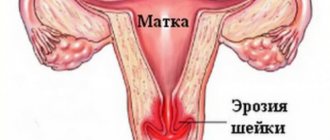In this article we will look at how childbirth occurs after the pessary is removed.
It’s nice when the pregnancy period proceeds without any complications, and the expectant mother is immersed only in wonderful dreams about her long-awaited little one. But in life, unfortunately, things don’t always happen the way we would like, and sometimes there is a threat of miscarriage along with premature birth. How can you maintain a pregnancy, how does childbirth go after removing the pessary?
When is it installed?
There may be direct and additional indications for the installation of a uterine ring.
Direct indications for wearing a pessary include diagnosed isthmic-cervical insufficiency. At the next scheduled or unscheduled ultrasound, it may be discovered that the length of the cervix does not correspond to the required norm - 4 cm. A length of less than 2.5 cm is considered pathological. In addition to this, it may be discovered that the external or internal os in the uterus is open. The combination of these factors is a direct indication for the installation of a pessary, since the weight of the growing fetus and its pressure on the thinned cervix can provoke premature birth.
Additional indications for the installation of a uterine ring include:
- a history of miscarriages and premature births;
- multiple pregnancy;
- the presence of sexual infantilism;
- ovarian dysfunction;
- if pregnancy occurs after long-term infertility treatment or as a result of insemination or IVF;
- repeat pregnancy after surgical delivery by caesarean section;
- in the presence of great physical and emotional stress in a pregnant woman.
However, the procedure for installing a pessary is not carried out if there is a need to terminate the pregnancy due to the presence of a number of pathologies in the mother or fetus. Also contraindications for installation include:
- individual intolerance to materials;
- narrowness of the vagina;
- bloody discharge in the second or third trimester;
- the presence of inflammatory diseases requiring immediate treatment;
- prolapse of the membranes;
- pronounced degree of ICI, in which only suturing is indicated (for more details, see the article: signs and treatment of ICI during pregnancy).
The need to install a pessary, which is a tight ring, on the cervix usually occurs in the second trimester of pregnancy in women with identified pathologies of the cervix. The function of the ring in this case is to keep the uterus closed, thereby preventing miscarriage or premature birth.
As a result, the pressure of the fetus on the cervix from the inside is compensated and distributed more evenly.
Most often, a pessary is placed after the 20th week of pregnancy and up to 32–33 weeks. The procedure is quick and virtually painless. But the very installation of a rubber or latex ring can provoke labor or miscarriage, and therefore doctors always weigh existing and potential risks.
The installed pessary with its edges rests reliably on the vaginal vaults, which provides it with a reliable and stable position.
A pessary is not capable of making a pathologically short cervix longer during pregnancy; it only allows, in most cases, to prolong pregnancy with high efficiency.
Excessive physical activity, sexual intercourse, stress and anxiety are prohibited. Once a week, it is recommended to do a smear test to determine the state of the vaginal microflora: this will help eliminate infection. Vaginal irrigation suppositories are often prescribed.
Features of the device installation procedure
The use of a uterine ring reduces the risk of pregnancy failure and premature birth by approximately eighty-five percent. Immediately before the device installation procedure, women need to cure existing infections. Ideally, this should be done at the planning stage of the child.
The installation process of this device can cause minor discomfort, but it quickly passes. To reduce the intensity of unpleasant sensations, the pessary is lubricated with a special cream or gel. This device is made in various sizes so that the doctor can select a pessary individually for the patient in accordance with her physiology. The correctly chosen size determines how accurately the ring is installed and how quickly the patient adapts to it.
In the future, unpleasant feelings will not arise, although during the first few days after installation of the device, you get used to it and it can put slight pressure on the bladder. When, due to physiological reasons, the doctor is forced to set the pessary low, then during the entire period of its use (throughout the entire pregnancy), the woman will be able to feel the urge to urinate more often than usual.
What is a pessary?
An obstetric pessary, also called a relief pessary, is a product widely used in urology and obstetrics. Its main purpose is to support the cervix to reduce fetal pressure on it, distribute the load and prevent premature birth. The most commonly used design is in the form of a plastic or silicone ring, but there are products in the form of a bowl, cube, cone or mushroom.
The introduction of an obstetric ring ensures the preservation of pregnancy until natural birth. The device is made of material that does not provoke allergies and easily adapts to the anatomical features of the uterus. It's soft, but resilient enough to do its job.
Precautions after inserting a pessary
To avoid the development of a number of pathologies after the introduction of the uterine ring, gynecologists carefully monitor the woman’s condition and well-being. To do this, she is prescribed:
- visiting the antenatal clinic once a week;
- taking smears and cultures from the vagina every two weeks;
- vaginal ultrasound (ultrasonography) to check the length and condition of the cervix once a month.
In addition, the pregnant woman herself should: for the entire period of wearing the pessary:
- refuse vaginal intercourse;
- pay special attention to genital hygiene;
- remind the doctor during the next visit to the antenatal clinic about the need to check the position of the ring;
- reduce physical activity to a minimum.
It is strictly forbidden to try to remove or adjust the position of the ring yourself if any discomfort or unusual discharge occurs. The ring must not be reinstalled. It is worth mentioning that the nature of the discharge may indicate the presence or absence of any pathologies.
- Brown (bloody). If traces of bleeding were detected a couple of days after the ring was installed, they can be associated with mechanical damage to the tissue during the procedure. If later, you need to tell your doctor about it.
- Yellow or green. Yellow or green mucus and foam indicate the presence of STDs, which pose a serious threat to the normal development of the child.
- Transparent and abundant. A large amount of colorless and odorless liquid is a signal that amniotic fluid is leaking. In this case, you need to conduct a rapid test yourself or call an ambulance.
How does labor begin with a pessary?
For many women, the birth of a baby is the greatest miracle, because they waited for pregnancy for many years or had great difficulty in carrying it to term.
Some representatives of the weaker half of humanity have to spend almost the entire 9 months in hospital care. Others are forced to wear a pessary in order to keep the child in the womb.
How does labor begin in women with such a device? What should you know about him?
Pessary: to whom, why, when?
This is the name of a special device, which is also called a uterine ring and is installed on women to maintain pregnancy. It consists of several rings of different diameters combined with each other.
The obstetric pessary is made from environmentally friendly materials that are safe for the health of the expectant mother. These are mainly plastic and silicone. The edges of such a medical device are smoothed.
Its surface is specially treated to eliminate the risk of injury to internal tissues.
There are certain indications for wearing a pessary:
- Isthmic-cervical insufficiency in a woman. This is the main indication for installing the device. With this diagnosis, the neck of the main reproductive organ softens and becomes thinner, which does not allow it to hold the growing fetus. Sometimes it may partially open. And this poses a risk of premature birth.
- History of miscarriages and premature births. In such cases, the doctor also recommends that the pregnant woman install an obstetric device.
- The presence of ovarian dysfunction or infantilism of the internal genital organs.
As an additional insurance, a uterine ring is installed for expectant mothers in the following cases:
The uterine ring in all of the above situations cannot be a panacea. This is not a guarantee that the fetus can actually be carried to term. Therefore, sometimes doctors resort to another, more complex manipulation - suturing the cervix.
This procedure is carried out when a woman has contraindications for wearing a pessary.
These include individual intolerance and prolonged discomfort; narrowness of the vaginal opening; pathology of the fetus, when there is a need to terminate the pregnancy; colpitis, causing displacement of the uterine ring; prolapse of the amniotic sac; the appearance of bloody discharge.
Can labor begin with a pessary?
Yes, this happens. And every competent doctor is obliged to warn his patient about this.
She should know that timely installation of a pessary is an auxiliary measure, and not a complete guarantee that a woman will carry a pregnancy to 40 weeks. Labor may well begin with the uterine ring installed.
In this case, the expectant mother should trust her doctor. Only by strictly following his instructions can you safely give birth to a healthy child in the later stages.
If the pregnancy is full-term, and it is considered so at 38-39 weeks, then when the water breaks and contractions begin, the woman’s pessary is removed. This procedure is painless. And then everything goes as it happens in normal childbirth. There is no need to be afraid that the pessary will hold back labor.
If it's time for them to start, then it will happen. By the way, women usually have their uterine ring removed at 38-39 weeks. After this, several days or a week may pass before labor begins. And sometimes labor can be rapid.
Even an experienced gynecologist will not be able to predict this.
Purpose and contraindications for use
The use of an obstetric device is not always appropriate. Its use is contraindicated for:
- protrusion of the membranes;
- presence of bloody discharge;
- bladder dysfunction;
- suspicion of a frozen pregnancy;
- inflammatory diseases of the genital organs;
- severe somatic illnesses;
- last degree of ICI (it is not advisable to use a pessary as the main method of correction).
Pregnant women are prescribed a pessary if the cervix cannot support the fetus. The gynecologist inserts a silicone ring into the vagina, and as a result, pressure is redistributed from the fetus to the cervix. Mucus discharge often appears, especially in early gestation. A patient with this form of the disease is treated in a hospital setting to save the fetus.
Due to this ring, the uterus is held and this prevents the mucous plug from detaching from the genital organ. Some patients are prescribed this procedure with suturing. The doctor, in addition to inserting the pessary, also makes several fixing sutures. There are some contraindications that are incompatible with the pessary. It is strictly forbidden to place a ring if:
- the woman was diagnosed with symptoms of a frozen pregnancy;
- a prolapse process has occurred in the amniotic sac;
- inflammation has formed in the reproductive system;
- There was bloody discharge from the vagina.
The technique is a little painful. It is carried out for approximately 40 seconds. The specialist initially treats the ring with a special gel. After the manipulation, the doctor informs the woman about what needs to be done when wearing a pessary. The doctor’s recommendations include compliance with hygiene rules, as well as antiseptic treatment of the genital organ.
The use of antibacterial suppositories is prescribed. A pregnant woman should take preventive measures to avoid the addition of infectious bacteria. If a discharge forms after a pessary, the patient must urgently come for examination to a specialist.
Woman's behavior while using a pessary
In most cases, for women for whom a doctor has installed a uterine ring, the same rules of behavior and daily routine are relevant as for other pregnant women. However, there are still some recommendations specifically for such patients.
- If a woman is diagnosed with ICI, she is contraindicated not only from traditional sexual intercourse, but also from any overexcitation in general that can lead to an increase in uterine tone. In this case, it is prohibited to engage in any types of sex, watch stimulating programs or films, read erotic novels, etc.
- The pessary does not require hygienic care. Every few weeks, a woman will have to take a smear to determine the degree of cleanliness of the vagina, and depending on its results, the doctor may prescribe additional irrigation or suppositories. Usually, the doctor recommends undergoing this examination at least once every 2-3 weeks, but depending on the indications, he may prescribe it more often.
- Periodically, the doctor should monitor the position of the pessary and monitor the condition of the cervix.
- The pessary is worn throughout pregnancy (from the moment the indications for its installation are identified) and is removed several weeks before the planned birth. Typically, your doctor will decide to remove the device at around 36-38 weeks, but not later.
- Early removal of the obstetric device is indicated if inflammatory processes occur in the vagina or if the pregnant woman needs early delivery due to certain medical conditions.
Unfortunately, even timely installation of a pessary cannot provide a complete guarantee that pregnancy can be maintained until the required period. Labor can also begin with the uterine ring installed. In any case, a pregnant woman should not fear any complications after removing the device. Only the exact implementation of all the recommendations of the attending physician will make it possible to simplify and facilitate the course of pregnancy as much as possible and bring the baby to its due date.
Hi all! They discovered that my cervix was slightly opened to a depth of 4 mm with a length of 40 mm; the day after tomorrow they will put a ring on it. I have 3rd B, 22 weeks. (the first without problems, my son is almost 5 years old, the second froze at 4-5 weeks a year ago). Girls, who received the rating, tell us about the “+” and “-” in your opinion. How does the installation procedure go, does it hurt or not, and then what happens during the wearing process? Thank you all in advance.
Is the external or internal os open? My first B ended in premature birth (though it was twins). Oh, the second time I got on my nerves! We looked at it at 18 weeks on a chair - the opening was 1 cm. They put it in storage and scared us to sew it up (we don’t put rings on it). Then I myself read that a slightly open external pharynx is the norm for the second and subsequent B. the main thing is that the internal pharynx is closed and the neck is not shortened. I ran for an ultrasound - the internal os was closed, the cervix was 34 mm. I double-checked it elsewhere and was convinced that this was the case. and scored on everyone. Doctors' job is to play it safe. After that, I just lay there more, rested, and periodically looked at my cervix on an ultrasound scan. I had it all the way B - slightly open from the outside, 34-36 mm. and I carried the baby to term. so see for yourself, but it all depends on which pharynx is slightly open. consult another doctor. It’s also better not to place a ring without clear indications.
Yes, it really hurts a lot for a minute, and then my stomach drags a little during the day and that’s it. But after the installation at 22 weeks, false contractions began at 24 weeks and continued throughout the pregnancy. Well, not fights, petrification. I don’t know, it’s connected - no. But the neck at the time of installation was 20mm, the opening of the internal throat was mm4. Of course, I lay down all the time and didn’t sit at all until I was 32 weeks old. Well, there was no thrush, just a lot of discharge like water. Well, I couldn’t think about sex anyway - I was afraid of hurting it.
Placed at 24 weeks. , I don’t know about anyone, but it was much more painful for me to take it off than to put it on, with + a little confidence that the pessary would protect my neck from opening, with - profuse discharge. I didn’t feel it at all while wearing it. The pessary really helped me maintain my pregnancy... They took it off at exactly 37 weeks. , gave birth on the same day. Good luck to you and your little belly, everything will be fine!!!
I was admitted to the hospital with the opening of the external pharynx and shortening to 27 mm. At 31 weeks, a pessary was inserted, it was painful during installation... Science, if you compare it with installing a speculum in the vagina... Multiply the pain by 3-4, and it’s a bit painful. Well, you know, it’s not the uterus that hurts, but the vagina, because they stretch it with this ring, and then turn the ring into the vagina, and that’s what hurts. But the cervix and uterus itself do not hurt, they do not suffer during this procedure, do not worry about this. As soon as they put it on, you need to lie down for a couple of hours so that there is no tone, for example, I was immediately given magnesium drops, just to be on the safe side. But I don’t think it was necessary. You feel the ring for about 2-3 hours, only because the memory is fresh))) but in theory you don’t feel it at all, well, it’s scary to go to the toilet for the first time))) you keep thinking that you’ll blow it out right now))) don’t be afraid if you immediately After installation, you practically don’t feel it, and then there will be no discomfort. Pros - you are mentally calmer, you are more confident that you will deliver on time. Disadvantages - lack of sex, constant sanitation of the vagina (I put neopenetran suppositories 5 through 10). Removing the ring is simply scary))) because you know the sensations during installation, but the vagina becomes more elastic before childbirth and it is easier to pull the ring out, and in general there will be no pain, just think that soon the head will pass through there, so the ring is garbage . I was removed at 37.6, last Friday, and I’m still walking... I haven’t given birth yet, today they looked at my cervix, it’s closed and tight. They said I’ll have to wait another week))) so they fixed the pessary specifically around my neck.
Girls, thanks for the answers and support. They installed it for me today. It's fast, but damn, it hurts. They gave me size 2 because... I've already given birth. The ring scraped against the bones, that’s what it felt like. I survived. then funny. I don't feel it now. I hope it will be easier to remove.
Isthmic-cervical insufficiency, leading to premature dilatation of the cervix during pregnancy, was considered a death sentence for the fetus back in the middle of the last century. Fortunately, this problem can be solved these days, and the obstetric pessary has completely replaced the suturing of the cervix that was practiced a couple of decades ago. Why a pessary is installed during pregnancy and what its main functions are is the topic of our article.
When will labor begin?
The presence of a pessary on the cervix does not in any way affect the onset of labor; it does not prevent the waters from receding. Often, pregnant women with ICI, to whom auxiliary preservation methods were used, are admitted to the maternity hospital long before the expected date of birth. However, sometimes things don’t go according to plan and your water breaks before the scheduled date. In this case, you need to call an ambulance and go to the maternity hospital with all things prepared in advance.
Women who have had their pessary removed on time, on time, before the onset of labor, are very interested in knowing when to expect the onset of labor. The baby can begin to be born at any moment.
Sometimes it takes about half an hour after removing the latex ring before the first contractions begin, and sometimes you have to wait. On average, statistics show that most women in labor give birth 7–9 days after the fixation device is removed.
Following this, the external pharynx begins to open. This process is gradual, smooth, so the first signs of the approaching of the cherished day may be changes in the sensations of the expectant mother: aching, aching pain in the lower back appears, the mucous plug comes off, which can no longer be in the cervical canal due to its expansion when the internal pharynx opens.
Labor pains will lead to a gradual opening of the external pharynx. The cervix must dilate completely to 10–12 centimeters in order to release the baby from the uterine cavity into the birth canal.
You should not think that the very fact of the presence of a pessary during pregnancy can in any way affect the upcoming birth processes. If the fixation device does not cause infection, then the birth will be the most ordinary, no different from others.
There are also cases where pregnancy was maintained by fixing the cervix with an obstetric pessary, and after its removal, spontaneous labor did not develop until 41–42 weeks, and therefore there was a need to induce labor.
Leakage of amniotic fluid before birth
The breaking of water before childbirth is accompanied by contractions. The first contractions of the uterus begin immediately after the release of amniotic fluid, although this also happens 11-12 hours later. Normally, by this time the woman’s cervix is softened and slightly open. That is, the body is ready for the birth process.
What does it look like
There is no clear answer to the question of how pregnant women’s water breaks before childbirth. The process occurs individually for each woman. Some women feel a slight pop, after which liquid comes out.
The process is not accompanied by pain until contractions begin.
How else does the water break before childbirth: for some, fluid begins to leak a little, and a feeling of moisture appears in the perineum.
Green waters
Knowing what a pregnant woman’s water normally looks like when it recedes helps to notice the emergence of problems in a timely manner. They should be colorless or slightly pinkish. Cloudiness and whitish flakes may appear.
If the color of the liquid is green, it means that original feces have entered it, which indicates a lack of oxygen for the baby. Red color indicates bleeding. Both signs are dangerous signals, so it is important to pay attention to what color a pregnant woman’s water is when it breaks.
Normal waters should be clear, almost colorless
Why is this happening
Labor can begin either with contractions or with the rupture of water. Often this happens at the same time, for which there is a simple explanation: during contractions, increased pressure is created in the amniotic sac, and it ruptures - the fluid comes out, which is why the water breaks during pregnancy.
First signs
Doctors explain that the first signs of rupture of water in pregnant women may differ. Usually this process is painless, since the amniotic sac does not contain sensitive nerve fibers. As a result, the woman feels the release of fluid. If your water breaks coincides with contractions, then soreness may be present.
What comes first – contractions or water?
Almost all first-time mothers are concerned about what comes first – the contractions or the water breaking. It may be different. Often amniotic fluid is released initially. It frees the baby for further passage through the birth canal. Sometimes there is a so-called rehearsal of contractions, when a woman feels a nagging pain in the lower abdomen, but this is not yet the process of childbirth. But if the fluid is gone, the contractions are already real.
Contractions can begin before the water breaks, logically leading to them. It also happens that these events occur almost simultaneously, which is impossible to track.
Can my water break without contractions?
The question of whether water can break without contractions and how dangerous this situation is worries many pregnant women. This can happen if the wall of the bladder becomes thinner and the pressure in it increases. This leads to the release of amniotic fluid, which is not accompanied by contractions.
This can be caused by a fall or a blow to the stomach, or severe emotional or physical stress. Only an obstetrician can determine whether the birth process is proceeding correctly and why the water breaks prematurely. He will assess the condition of the cervix, and by its dilation he will understand how ready the body is for childbirth.
A woman needs to know what to do if her water breaks without contractions. First of all, turn to specialists. If childbirth occurs naturally, contractions may occur several hours later, which is not a deviation. If prenatal discharge of water occurs, which the doctor learns about during the examination, a decision is made about the possibility of saving the child.
You must inform your doctor about any changes.
Can water break during urination?
On the eve of childbirth, many women worry, coming up with difficult questions: how amniotic fluid breaks, whether water can break during urination, and many others. Although the solution is quite simple. During a visit to the toilet, amniotic fluid may be released, but the woman will feel it immediately. Firstly, there will be much more liquid than usual, and secondly, it does not have the specific smell of urine.
Is it possible without the plug coming out?
In order for the water to be released, the amniotic sac must open, and the liquid flows out quite rapidly and takes with it the mucus that covers the cervix and is called the plug.
Whether your water can break without a plug can be easily understood by talking with other women who have already given birth. In fact, the plug is simply carried away with the flow of liquid, so there is no way without it. However, if amniotic fluid flows out gradually, then the plug may come out in parts, which is not very noticeable.
Does it happen unnoticed?
It is quite difficult not to pay attention to the release of water. Since their volume is quite large, the woman still feels the excess fluid. Even if an outpouring occurs during urination, a piece of mucus, as a rule, appears in front of the water - this is a plug, and the color of the liquid changes.
Even in a dream, women feel the changes that have occurred, so there is no need to be afraid of whether the water may recede unnoticed.
How many do they leave?
The amount of water that pregnant women lose is an individual indicator, depending on the characteristics of the body and the woman’s weight. Usually distinguished:
- anterior amniotic fluid, which is released immediately before contractions, its volume is about 0.8-1 liters;
- the posterior one, released after childbirth, its volume does not exceed 200 milliliters.
Can my water break with a pessary?
A pessary is a special device installed in women to redistribute pressure in the pelvic organs. It is usually removed a week before childbirth, but sometimes the process begins earlier. Whether the water can break with a pessary, for example, during premature birth, it is better to immediately ask your doctor. As experts note, the device does not block the process and if labor begins, it proceeds as usual.
Various pessary options
Why ahead of schedule
Premature rupture of water is always a dangerous sign, which may indicate both labor that has begun before term and the presence of health problems for the baby.
Reasons for early fluid release may include:
- stressful situation;
- strong change in water volume (polyhydramnios);
- injuries and falls;
- multiple pregnancy;
- the presence of inflammatory or infectious diseases of the genital tract;
- medical intervention.
Contractions and childbirth after removal
It is impossible to refute the opinion that labor cannot begin immediately after removing the obstetric pessary. In most cases, women wait another 10–14 days to meet their child. However, there are often cases when, after removing the uterine ring, a pregnant woman’s waters break within 20–30 minutes and contractions begin (more details in the article: how long will it take for contractions to begin if the waters break?).
The activation of delivery after removal of the pessary is explained by the fact that the cervix, which it holds, without additional stimulation, begins to soften and open too quickly, which provokes the onset of contractions.
In order not to miss the moment of the onset of labor, after the procedure for removing the device, the woman is asked to stay in a medical facility for some time. The doctor decides how long you need to spend in the hospital. Usually, after an hour and a half, an additional examination is carried out to assess signs of cervical dilatation and removal of the mucus plug. If none of this is available, the woman is sent home, since she will not be able to give birth in the coming days.
Contraindications
Unfortunately, sometimes in order to maintain a pregnancy, doctors are forced to resort to a more complex procedure, namely suturing the uterine cervix. This may be prescribed when there are contraindications for installing a pessary:
- Intolerance to obstetric devices, prolonged discomfort when using them.
- The presence of fetal pathology when there is a need to terminate the pregnancy.
- The vaginal opening is already fifty millimeters.
- Colpitis causing displacement of the device.
- The occurrence of bleeding.
Many people are wondering, after removing the pessary, how long does it take for labor to begin?
Types of obstetric pessaries
Gynecological devices are produced by many companies and differ in shape, as can be seen in the photos provided. The pessary is selected individually, taking into account the specific structure of the patient’s genital organs. The following types are often used in obstetrics:
- Ring. The design is made in the form of silicone rings with holes that allow secretions to pass through. The disadvantage of the product is that it is not securely fastened - it can fall out.
- Cube. Cube-shaped design that ensures normal outflow of vaginal discharge.
- Dount. The product looks like a donut, performs its task well, but leads to stagnation of vaginal secretions.
- Cellhorn. A reliable gynecological pessary that protects against premature birth. It does not delay discharge and is tightly fixed in the vagina, but can provoke unpleasant sensations.
The choice of pessary depends on the diameter of the upper third of the vagina, the cervix itself and the number of births the patient has. There are three sizes of this device:
- The product is installed on women who have not given birth or who have already become mothers twice. The diameter of the cervix should not exceed 30 mm, and the length of the upper 1/3 of the vagina should be up to 65 mm.
- It is used under similar conditions, but the length of the upper third of the vagina is 66–75 mm.
- The device is placed on women who have given birth multiple times, with 1/3 of the vaginal length exceeding 76 mm and a cervical diameter of 37 mm.
What do you need to know?
The main thing that women need to remember about having a pessary installed is that it does not provide an exclusive guarantee of maintaining the pregnancy until the required term. In addition to it, hormonal and drug therapy should be present in combination with adherence to a gentle daily routine.
Unfortunately, not every obstetrician-gynecologist knows how to correctly install the uterine ring. However, if there are indications for wearing it, it is better to play it safe and look for a specialist who knows how to install a pessary.
Can labor begin with a pessary?
Yes, this happens. And every competent doctor is obliged to warn his patient about this. She should know that timely installation of a pessary is an auxiliary measure, and not a complete guarantee that a woman will carry a pregnancy to 40 weeks. Labor may well begin with the uterine ring installed. In this case, the expectant mother should trust her doctor. Only by strictly following his instructions can you safely give birth to a healthy child in the later stages.
If the pregnancy is full-term, and it is considered so at 38-39 weeks, then when the water breaks and contractions begin, the woman’s pessary is removed. This procedure is painless. And then everything goes as it happens in normal childbirth. There is no need to be afraid that the pessary will hold back labor. If it's time for them to start, then it will happen. By the way, women usually have their uterine ring removed at 38-39 weeks. After this, several days or a week may pass before labor begins. And sometimes labor can be rapid. Even an experienced gynecologist will not be able to predict this.
Premature birth with a pessary
Unfortunately, even with a pessary, women are not always able to carry a child to term at which it will be viable. Labor may begin prematurely. If this happens in the third trimester of pregnancy, then there is a chance of saving the child. Modern medicine in our time can adequately support children with low weight. But everything is individual. There is no need to be afraid if a pregnant woman with such a device gives birth in the later stages.
Women should not be afraid of having a uterine ring installed. Childbirth with such a device will occur in the same way as normal, because the pessary is simply removed.
How long does it take to place a pessary?
The optimal period for introducing a pessary is from 16 to 34 weeks after conception. Installation time varies depending on the characteristics of the pregnancy. Usually the device is inserted after the 20th week, but sometimes it has to be done at 12–14 weeks. The doctor decides at what time the product should be installed. In the first trimester, regardless of the number of births, a ring of the first size will suit a woman.
The expectant mother will have to wear the device throughout her pregnancy, so infection prevention is carried out before inserting it. Most often, vaginal suppositories are used for these purposes.
Installation process
The pessary is installed in 15 minutes. Depending on its form, the method of administration may differ, but the process looks something like this:
- the pregnant woman, after urination and defecation, lies down on the gynecological chair;
- the ring is treated with glycerin oil to facilitate its advancement;
- the device is inserted and positioned so that its wide end is deep in the vagina, and its narrow end is under the pubic bones.
The design is made in such a way that it covers the cervix and does not allow it to open. If a woman has uterine hypertonicity, she needs to take an antispasmodic half an hour before the procedure.
The sensations during installation of the device depend on the professionalism of the doctor and the pain threshold of the patient. Many expectant mothers say that this is more unpleasant than painful. In addition, women are willing to endure pain, since often this procedure is the only way to preserve the pregnancy. Sometimes the doctor may use a local anesthetic. The installation process of the product is shown in the video.
What is the installation procedure like?
After I was discharged, I went to the gynecologist to have a ring installed. The period was 26 weeks. The installation is performed in a gynecology department. That is, I came to the reception and brought a ring. You lie down on a chair as if for an examination. The doctor unpacks the pessary and treats it with a special liquid. Then he asks you to relax as much as possible. It’s quite difficult to do this; after all, nervous tension takes its toll. I suggest several ways:
- Place your hands on your chest.
- Inhale deeply a couple of times.
- Imagine that you are at home, on your bed.
- And the hands that are picking at you “there” are not a doctor, but a husband.
Experienced gynecologists place the ring quickly, literally in one motion. Chick – and it’s worth it. I was lucky, my doctor installed the pessary quickly and almost painlessly. But this does not always happen; in exceptional cases, a situation arises when the doctor places the ring crookedly, takes it out and puts it back on. Problems occur if a woman’s muscles are too tense and it becomes difficult to push the ring in. Try to relax!
And let's figure out what the functions of the ring are.
- It supports the baby's head and prevents him from sliding down.
- The pessary relieves the load on the cervix, it does not open.
- With a pessary, a woman can do household chores more calmly, without worrying that premature labor will begin.
Don't worry, you won't feel the ring inside at all! Although this thing looks huge, it turns out that inside the pessary takes up little space. Or it's very convenient. Doesn't sting, doesn't burn, doesn't rub. The only thing is that you cannot have sex with a pessary. Although, if there is a threat of miscarriage, this is a natural warning.
How is it filmed?
Do not think that removing a pessary is a more difficult task than installing it. Typically, removing a latex or rubber ring from the cervix is even easier and faster than inserting it. After removal, you must carefully observe the rules of intimate hygiene and irrigate the genital tract with a solution prescribed by the doctor.
The pessary is usually removed at 38 weeks. It should be noted that the preparation of a pregnant woman’s body for childbirth does not depend at all on whether she has a fixation device on her cervix or not. Everything goes on as usual, and therefore 38 weeks is considered the optimal time to remove the ring. The child is mature enough to easily adapt to his new environment after birth. The birth canal is also almost always ready by this time; the hormonal background is “tuned” to labor.
Removal
Removing the pessary, as a rule, does not cause any discomfort. It is usually easier than installation. Such a device must be removed by a doctor who monitors the woman’s pregnancy. Following the removal of the device, sanitation of the birth canal should be performed over the course of a week to prepare the woman for the birth of the child.
Premature labor does not begin after removing the obstetric pessary, and many women fear this. Only if the pessary is removed due to the appearance of symptoms of labor, labor begins immediately after its removal.
Features of wearing and restrictions
After installing a pessary, a woman’s lifestyle remains the same, but with minor restrictions. The expectant mother is advised in detail about what she can and cannot do. Basic recommendations:
- stop intimate contacts;
- limit physical activity - a pregnant woman needs more rest;
- try not to squat or bend over;
- avoid constipation;
- do not take baths or swim in bodies of water;
- visit a gynecologist every 14 days (he will conduct examinations to make sure that the pessary has not fallen off and is located in the same place);
- use suppositories regularly to prevent infections;
- Have a vaginal smear every couple of weeks.
Beginning of labor
One of the most common questions is whether labor can begin before the ring is removed. They can, because, as we have found out, internal preparation for this reflex act in no way depends on whether there is a foreign body on the cervix or not.
Childbirth with a pessary installed after the 37th week of pregnancy should not be perceived as a tragedy. The baby is full-term, and the birth process itself will not differ much from the classic one, except that the dilatation of the cervix will proceed somewhat faster, which will in a certain way reduce the total time of labor.
The onset of labor may be indicated by regular contractions that begin to repeat with a certain frequency. The onset may also be marked by the release of amniotic fluid.
If a pregnant woman without a pessary can afford to stay at home until the contractions gain a certain strength and intensity, then the expectant mother with a ring on the uterus should call an ambulance immediately. To prevent damage to the cervix, the pessary should be removed as soon as possible.
There are times when during contractions the pessary slips off on its own, but it’s better to be on the safe side. In the maternity hospital, the obstetrician will definitely remove the pessary, and the further course of labor will be normal. You should not assume that labor will necessarily be rapid or rapid when the pessary leaves its place and ceases to fix the cervix. No pattern has been identified between wearing a pessary and precipitate labor; the risk of such abnormal labor is at basic values, as in women who did not wear a uterine ring.
The onset of spontaneous labor with surgical sutures placed on the neck is much more dangerous. During contractions, they can “cut through” the cervix, leading to severe injury.
If there are no associated pathologies, after removing the pessary at 38 weeks, they can be sent home to wait for the onset of labor. If there are other complications of pregnancy, the woman will most likely be left in the hospital under the supervision of doctors.
Precursors of rupture of amniotic fluid: what do they look like?
Precursors of discharge of amniotic fluid
For all future mothers, be it a “firstborn” (a woman giving birth for the first time), or an already experienced mother of many children, amniotic fluid drains in different ways:
- For some women, this is a sharp clap, reminiscent of the clapping of palms, and an abundant outpouring of liquid - warm in temperature, usually transparent or slightly pinkish.
- In other women in labor, amniotic fluid may slowly leak, partially pour out, and sometimes it even recedes during contractions.
Precursors of rupture of amniotic fluid: what do they look like? Here are some typical symptoms:
- Before the amniotic fluid leaves, tension builds up in the lower abdomen.
- There is a feeling as if you want to go to the toilet, but the birth is still far away, since the cervix has not yet softened.
- The tension does not let go, even between contractions. It seems as if the woman’s body wants to push something out from within. There is usually no pain. Slightly sipping sensation in the lower back and lower abdomen.
- Then a sharp bang occurs, and the woman in labor feels relief; at this moment a large amount of water pours out. The amniotic sac bursts and some of the amniotic fluid spills out.
Usually a woman feels that her water has broken. But it also happens that you may not notice and even miss it. Read on.
Possible complications
Since the obstetric retention pessary is a foreign body that remains in the body for a long time, complications may arise when wearing it:
- frequent and strong vaginal discharge (if it is clear and odorless, no need to worry);
- some women find it uncomfortable to sit - if they stay in this position for a long time, unpleasant sensations may occur;
- the device can jump out of place, which provokes the development of colpitis (the problem is eliminated by returning the product to its optimal position and taking medications);
- one of the serious complications is inflammation of the membranes and infection in the amniotic fluid;
- It is also possible for the vaginal walls to wear out, bleeding or ulcers of the mucous membrane to appear.
A woman with a pessary installed needs to behave carefully and undergo regular examinations. An alternative to wearing a device is surgery, in which the cervix is sutured, but this entails more negative consequences.
How does a pregnant woman feel if the pessary has moved?
If the doctor has selected the correct size and placed the product correctly, the woman should not feel discomfort. A silicone or plastic pessary has rounded edges, so it cannot injure soft tissue.
Many women who need a device placed wonder if it might fall out. In the literal sense, this will not happen, but the product can change its position (which happens very rarely). You can understand that the pessary has shifted by the pronounced discomfort and feeling of the presence of a foreign body in the vagina. The ring will put pressure, which will be especially felt when bending over and in a sitting position. At the same time, white discharge may appear.
Most often, the structure is not held in place due to the wrong size or the unprofessionalism of the doctor who installed it. If discomfort occurs, it is better to consult a doctor as soon as possible - delay threatens inflammation of the vagina. If there are errors in choosing the size or shape of the product, it will need to be replaced.
Reviews
According to reviews from women, when removing the pessary you need to be fully prepared (pack your bag for the maternity hospital, prepare the necessary documents and things), because labor can begin almost immediately after removing the ring. The wait after removal can be quite painful, especially if you have to wait for quite a long time.
Many people worry that labor is not starting, although after removing the fixation device, the doctor stated that the cervix is 1–2 fingers dilated. You don't have to worry about this. The absence of a mucus plug and a slightly opened cervix is not yet a reason to believe that the life and health of the child are in danger. As long as the amniotic sac is intact, the baby has reliable protection from viruses and bacteria, but reasonable precautions are still necessary: while waiting for childbirth after removing the pessary, it is important to follow the rules of intimate hygiene, wash yourself several times a day, do not have sex, and do not douche.
Many women who have had repeated births after wearing a pessary claim that the birth process itself was simpler and easier than the first. Some first-time mothers also indicate that they were able to give birth quickly and quite easily because the cervix dilated faster.
Read more about the functions of an obstetric pessary in the next video.
How are the second births different from the first?
In multiparous women, the body experiences less stress during childbirth because it “remembers” the previous experience. Provided a successful pregnancy, all stages of delivery last less than during the first birth. The period of precursors (weight loss, increased volume of discharge, etc.) begins at 38 weeks.
The difference in the birth process between a primigravida and a woman preparing to become a mother again is significant:
- Preparatory stage. During the second birth, a woman may not have training contractions, which in first-time mothers appear several days before delivery. During your first pregnancy, your belly drops a couple of weeks before giving birth. This may not happen the second time: the belly will drop several days before the baby is born or on the day of birth.
- Opening of the cervix. During the first birth, it becomes cone-shaped, smoothes out and gradually opens; during the second and third, it takes on the shape of a cylinder, shortens and opens at the same time. Moreover, this process is significantly accelerated - on average, about 7 hours instead of 13.
- The duration of the labor process in multiparous women is shortened by approximately 2 times.
- Feel. Contractions of the uterus before the second birth become quite intense and painful almost immediately, as tissue sensitivity increases.
- Child's weight. Observations show that babies of multiparous women are born with a slightly higher weight. This may be due to more active blood circulation in the placenta.
For most women giving birth the second time, childbirth is much easier. They are not so afraid, they know how to lie down, breathe, count contractions, etc.
When and how is the pessary removed?
A pessary is needed until 36–38 weeks - during this period the fetus is already considered fully formed. It is removed at the next visit to the gynecologist. The procedure is carried out without anesthesia for a couple of minutes, pain occurs very rarely. When the device is removed, the woman can begin to actively prepare for childbirth.
Sometimes the removal of the unloading obstetric pessary needs to be done ahead of schedule. The procedure is carried out according to indications:
- infection of the amniotic sac;
- emergency childbirth;
- inflammatory diseases of the vagina that could not be eliminated with medications;
- early leakage of amniotic fluid.
When contractions begin, the device must be removed immediately. Otherwise, pressure on the genitals will increase, which can lead to venous stagnation and uterine damage.
Price issue
| Pessary name and manufacturer | Form | Cost in rubles |
| Yuno, Belarus | Flat, trapezoidal | 500–900 |
| PortexLand, UK | Ring | 700–900 |
| Dr.Arabin ASQ, Germany | Bowl | 4000–4500 |
| Hodge Pessary, Taiwan | Curved ring | 5000 |
It is difficult to name the best types of products, since the design is selected individually for each woman. However, with increased vaginal secretion, it is convenient to install the Dr. Arabin ASQ device - the perforation present in it ensures good outflow of fluid.
It must be remembered that any pessary is intended for one-time use and has an expiration date. When purchasing, you need to pay attention to the expiration date.
My second birth after removing the pessary
I'll start from afar)) My pregnancy was going well, everything was perfect, until at 33 weeks I started bleeding - almost every day. They brought me to the maternity hospital with suspected placental abruption, but the cause of the bleeding was not found, ultrasound and CTG were good. At the same time, it turned out to be completely unexpected for me that I have a very short neck - something like 1-1.5 cm. They put a pessary on and let me go. I decided a long time ago to give birth in the same hospital by contact (20 City Clinical Hospital in Moscow), at 36 weeks I signed a contract. My doctor said that pessaries are generally removed at 37 weeks, but because... I have almost no cervix - it is supported only by a pessary, so I need to wait until 38 weeks, as labor can begin immediately after removing the pessary.
So, at 37 weeks and 6 days I came to remove the pessary. I had Juno. It was not pleasant to photograph, but it was tolerable. The doctor said that most likely I would go into labor in the next 2-3 days and sent me home... Moreover, I had the idea of not going home right away, but I was worried about the car that was parked near the rd... I went home... I arrived... and I began to feel periodic contractions . I started noticing... 7 minutes, then 3... then 5-6-7... small contractions, almost not painful... I called the doctor, she asked me to come, because most likely I was in labor. I arrive by ambulance - that’s right - the baby has dropped, there is no cervix at all, I’m in labor. Then it’s standard - registration, enema (done very carefully))))), they take me to the birthing room - I have my own box, they do a CTG, they puncture the bladder, they give oxytocin. The dilatation is 3-4 cm. Here the contractions immediately began to be felt...
They put on an epidural, but I still feel all the contractions, but the pain is tolerable... The doctor sits with me almost all the time. The anesthesiologist periodically comes in and asks how things are going) Dilatation is already 6-7 - the process is moving rapidly... I begin to feel contractions already quite below, and they also radiate to the legs, you can’t push, you can only blow on the navel during a contraction - this helps the child to lower himself a little. And now they allow me to push a little, then it’s normal to push... I felt the baby moving millimeter by millimeter, slowly, slowly)) in total, in 4 contractions I pushed the baby. Everything else is standard. As a result, 5.5 hours passed from the moment of the very first contractions, 2 hours from the puncture of the bladder. Those. in fact, the most painful process took only 2 hours.
P.S. I often see posts on the topic of why a contract is needed. So, I didn’t regret the contract for a second. In my case, a personal doctor and control of my condition were very important to me. I also liked giving birth with a doctor in a separate box - I felt confident because the doctor literally controlled everything. Well, I was very pleased with the separate room with its own shower and toilet)) In our hospital, doctors are very interested in contracts - they get decent money from them, since they work directly with the hospital without any insurance.









